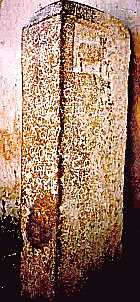by v ramchandra rao
Title: Kadireddi Miniraddi inscription Mulug dated 8th september 1065.
SUMMARY AND BACKGROUND
 This inscription details the appointment of a Reddi as in charge of a place in the western chalukya area of Mulug, now in Medak district Andhra Pradesh some 60 km north of today's Hyderabad.
This inscription details the appointment of a Reddi as in charge of a place in the western chalukya area of Mulug, now in Medak district Andhra Pradesh some 60 km north of today's Hyderabad.
Mulug is roughly halfway between Patancheru (pottelakere) and Kolanupaka (Kollipaka) which were important centres of the Kalyani chalukyas. The kalyani chalukyas supplanted the Rashtrakutas. They were followed by the kakatiyas, the yadavas, hoysalas etc. The kalyani chalukyas were earlier associated as feudatories under the powerful Rashtrakutas. As this inscription illustrates, the kalyani chalukyas often appointed Raddis ( rashtrakuta soldiers) as headmen of strategic villages in their dominions.
The inscription mentions the name of the appointee, the authorised appointer, the important personages of the areas and surrounding villages. A land grant was made at the time too. Interestingly enough, this took place almost a thousand years ago. Every village mentioned in the inscription is still around and flourishing. The Reddis, the Gouds, the mahajans ( i.e. important persons) agraharam residents etc are still prominent here. ( they need not necessarily be related to the persons mentioned in the text. )
I visited the villages and photographed the inscription pillar. It is known to the archeological department but has not been published. I managed to persuade the director and epigraphists for a summary and they obliged. Bulk of the translation was done by late NM Rao. I gave a copy to the local residents who were quite tickled to find their village names hadnt changed for the last 1000 years. They told me of one more inscription closeby. On inspection this also dealt with reddis... a descendant of miniraddi. An article on these was also published in APTimes in 1996 by me.
For a broad look, lets see what was going on elsewhere around this time say 1060-1070 AD?
West India--Pramara Bhoja after long career against Huns and Chalukyas passed away. Bhojpur lake (bhopal) was dug by him.
Tamilnadu- Kulottunga Chola consolidated his rule and resisted the W. chalukyas finally plundered their capital Kalyani too.
UP -- The Gurjara-pratiharas rajput kingdom was slowly falling apart.
England -- Frenchmen under William attack the anglosaxons, ultimately overthrow them.
Text is in Kannada language. The full accurate translation I'll post later after language experts take a look at it : here's some explanation. By the way kannada speakers can follow it quite easily. Ask one.
Chandanapura was a local head quarters of the governor Raviyaparaju. (ravi apparaju). Molanga is a place name even today -- Mulug village in south medak district. Remmanna Gouda was the local official. It records the procedure how Kadireddi Minireddi was formally appointed as headman (local boss) of the area in the presence of other headmen and important persons (maha janam) of the neighbouring areas. The witneses include reddis of the villages around mulug.
Many village names are listed. Almost one thousand years later the names are the same. ....molaga is mulug today, gajavalli is gajwel, pidiched is pirched , pamalapadi is pamulaparthi ( ex-PM PV's ancestors came from here) : kukkunda is today's Kokkonda : kondapaka is the same today, varagala is vargal .....all in the same area.. To mark the appointment he donated 2 'mattars' of land to the temple. I think kadireddi had to bribe the assembled people quite heavily, naturally this part wouldn't be mentioned in the official notice ;)
Raviyaparaju rajam chandanapura-da sayida-muvattura baliya Molanga gauda agrahaaramam padadure Remmanna gouda prabhugadu mahajanada munde KADIRADDIGAM MINIRADDIGAM magale dhaarayettida intapaddake saakshi maam.
(village name) ( commitee of important persons)
Molaga prabhugalam mahajanam
Pidicheda prabhugalam mahajanam
Pange prabhugalam mahajanam
Gajavalliya prabhugalam mahajanam
Pamala padi prabhugalam mahajanam
Kukkunda valle prajananam
(..in the presence of..)
Pidi Kommiraddi, Ravampalli Raddiyu, Mulongodaperi Vaidu raddi, Kondapaka Ketiraddiyu, Varagale Prabhugalam,
ivaru ubhaya mata
Dandimayya KADIRADDI vida komman amge
Tanna kereyalom 2 mattar nalem kotta mamagade teragilla
KADIRADDI kotta vithagalu baliyo..
(witnesses)
Chandanayyum, Gannayanum, Aakayya, Bovaru, (..worn out..), Ganamam, Revanum, (...worn out...)
(village name) ( commitee of important persons)
Molaga prabhugalam mahajanam
Pidicheda prabhugalam mahajanam
Pange prabhugalam mahajanam
Gajavalliya prabhugalam mahajanam
Pamala padi prabhugalam mahajanam
Kukkunda valle prajananam
(..in the presence of..)
Pidi Kommiraddi, Ravampalli Raddiyu, Mulongodaperi Vaidu raddi, Kondapaka Ketiraddiyu, Varagale Prabhugalam, ivaru ubhaya mata Dandimayya KADIRADDI vida komman amge Tanna kereyalom 2 mattar nalem kotta mamagade teragilla KADIRADDI kotta vithagalu baliyo..
(witnesses)
Chandanayyum, Gannayanum, Aakayya, Bovaru, (..worn out..), Ganamam, Revanum, (...worn out...)
There are thousands of inscriptions all over the country which are an excellent PRIMARY source for history and culture. This particular one dates from much BEFORE the Reddi kingdoms and EVEN the kakatiyas. So reddis and gouds have been a ruling community in these parts from quite a long time. I will write more details of this inscription, there are a few more interesting things.